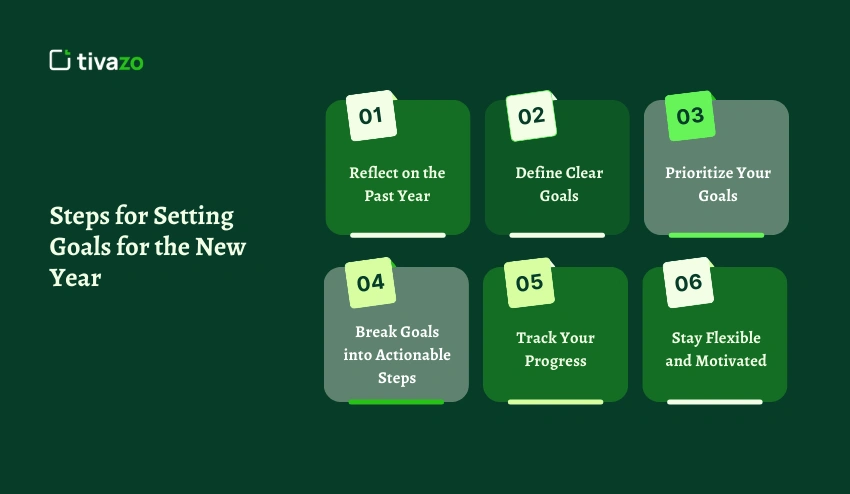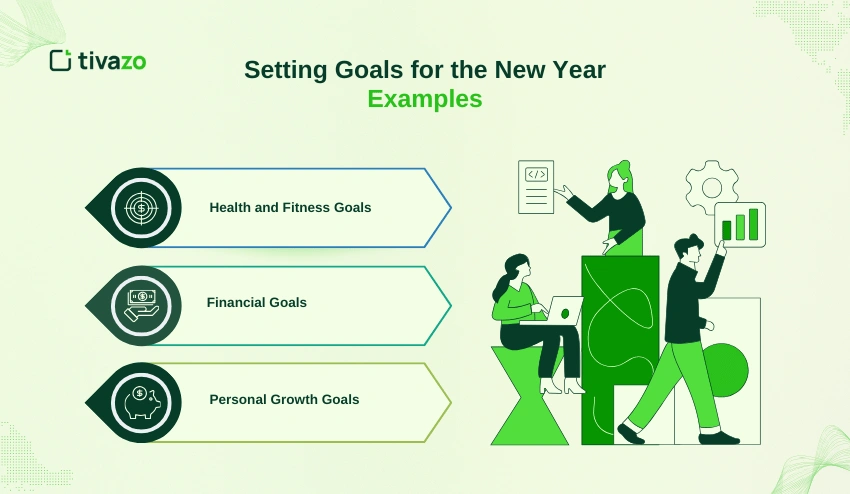Millions of individuals make New Year resolutions and give them up by February every year. But what were you thinking of not making even the new year goal setting a fly-by-wire promise?
And with the right plans, you can make dreams come true. With the experience of setting goals for the new year, breaking them down into manageable parts, and monitoring your progress, you will be able to keep yourself motivated and achieve actual results.
Setting goals for the new year is not about making a list but rather a roadmap that will help a person achieve success and grow personally. It may be improving productivity, changing bad habits, or organizing long-term targets, but it is important to know how to produce reasonable goals. This guide will also discuss some tips, goal-setting strategies, and self-improvement strategies that can enable you to stay on track with your plans and make significant strides over the year. Stop making half-hearted resolutions and start achieving tangible success in 2026.
What kind of goals should I set for the new year?
Personal, professional, and lifestyle goals make a combination in terms of providing the best performance when it comes to establishing goals in a new year. The first thing to do is find some areas in your life that you need to grow or improve upon this may be improving productivity, quitting bad habits or working on self-improvement practices.
To have a sense of direction, it is better to consider ensuring you have a roadmap, which is SMART goals: specific, measurable, achievable, relevant, and time-bound. Examples are learning a new skill, getting healthy and fit, or having long-term goals such as saving money or advancing in your career.
It is essential to track the progress, and a yearly goal planner or digital applications are used to track progress. With the help of setting achievable goals and dividing them into steps to be followed, you will be able to stick to your New Year resolutions and experience the real success during the whole year.
How to Set Goals For the New Year?
It is not just wishful thinking setting goals for the new year but making a plan and acting on it. Begin by looking back at the previous year: what succeeded, what failed, and what should be improved. This introspection will enable you to give more focus to personal improvement and have realistic goals.
The next step is to subdivide your objectives into small steps. Take SMART goals to make every target specific, measurable, achievable, relevant, and time-bound. Be it long-term plans, productivity, or personal-growth plans, it is better to have a systematic plan to achieve success.
Lastly, monitor your progress. An annual goal-planner, habit tracker, or tech can make you accountable and motivated. These steps will help you make your New Year resolutions come true and not lose dreams.
6 Easy Steps for Setting Goals for the New Year
The new year goals are not always easy to set, and it is reasonable to divide the process into simple steps. These six simple steps will help you to set realistic goals and keep yourself motivated, as well as measure your progress over the year.

1. Reflect on the Past Year
The initial way to start setting goals for the new year is to recount what happened last year. You should take time to check on your personal and professional accomplishments and even on places where you failed. In noticing patterns, habits, and results, you will be able to gain an understanding of what goals are actually meaningful and realistic in the coming year.
Reflective thinking also enables one to de-escalate habits which could have stalled you. It is either procrastination or time management, or unhealthy habits; whatever it is, when you learn these habits, you can add self-improvement tactics to your new objectives. This observation is vital in long term growth and planning.
Lastly, looking back at what you have accomplished makes you feel confident and encouraged. Being able to identify the things that worked well will assist you to set realistic goals, strategize on how you can accomplish them and have a positive attitude towards the goal accomplishment strategies. This makes your resolutions at the start of the year based on actual experience and not just wishful thinking.
2. Define Clear Goals
Goal setting is a very important process that requires goals to be specific and clear when setting goals for the new year. General solutions such as getting fit or saving money are normally unsuccessful since they do not give measurable results. The clarity and direction are achieved by using the SMART goal framework which consists of Specific, Measurable, Achievable, Relevant, and Time-bound goals.
Prioritization of time and resources is also achieved through clear goals. As soon as you are aware of what you are interested in accomplishing you are able to develop plans of the long-term goal, subdivide them into manageable steps, and monitor the progress effectively. This minimizes the possibility of being overwhelmed and enhances the chances of success.
Further, action is inspired through setting clear goals. Every quantifiable milestone is of course a checkpoint, holding you responsible and on track. No matter what you want to achieve, be it personal development, productivity, or bad habit cessation, clarity will help you keep your resolutions of the New Year in your mind.
3. Prioritize Your Goals
After setting clear goals, the next goal-setting activity is prioritization, which is carried out after having clear goals. Not every goal is as important, and doing all of them simultaneously may result in burnout. Determine what objectives are the most critical in your personal growth, career, or health, and address them initially.
Prioritization also contributes towards enhanced productivity. With high-impact goals, you are also able to put your energy on priority, minimize distractions, and develop a roadmap that is in line with your self-improvement strategies. This will make sure that your efforts will have a substantial yield rather than you becoming so thinly spread.
Lastly, prioritization of goals makes you motivated and responsible. Achieving high-priority goals generates momentum to finish the smaller or longer-term goals. This can be enhanced with the help of such tools as an annual goal planner or habit tracker, which will help you in setting goals for the new year more organized and realistic.
4. Break Goals into Actionable Steps
The major aspect of setting goals for the new year is breaking them into small, manageable bits. Big goals may be daunting, and without a roadmap of what to do, you may end up demotivated. You break your achievable goals into small bites, and by so doing, you develop a road map that will inform your actions day in, day out, or week in, week out.
This will also aid in one keeping track and being accountable. Smaller tasks offer more concrete milestones, and it is simpler to observe progress to continue. You have a goal of either being fit or planning your finances, or developing a new skill; it is always good to break it down so that you make steady steps towards it.
There are also steps that can be taken to minimize the risk of procrastination. When activities are achievable, then it becomes easier to commit and you will likely stick to your decisions. Step-by-step planning with productivity tips and a digital goal tracker are the three elements that can be coupled together to make dreams a reality.
5. Track Your Progress
Monitoring the progress is critical in achieving goals while setting goals for the new year successfully. It is hard to know whether you are on the right track or do you need to change your strategies without measurement. A yearly goal planner, habit tracker, or productivity apps are some of the tools that can help you get motivated with visual progress reports.
Constant monitoring also shows the points that should be improved. Busting bad habits, becoming more efficient, or working on yourself, taking a look at the progress will enable you to make changes to your strategy and keep moving. This makes sure that your goals are realistic and achievable throughout the year.
Lastly, recognition of minor achievements on the journey makes the commitment stronger. Even a small step should be recognized, and this will maintain the momentum, and burnout will be avoided. When you are able to track, your New Year resolutions become more than just another wish to achieve.
6. Stay Flexible and Motivated
Setting goals for the new year involves flexibility. Life is unpredictable, and strict arrangements usually result in disappointment. Flexibility enables you to modify goals, deadlines, or plans without forgetting what you are supposed to achieve in the long run.
Being motivated does not just take the determination to do it, but a positive attitude and enjoying the progress. Self-improvement strategies, milestone rewards, and record of achievements are to be used to strengthen commitment and enthusiasm across the year.
Lastly, it is best to integrate both flexibility and motivation so that your resolutions of the New Year can be maintained. Through a constant assessment of objectives, modification when necessary and a record of the achievements you gain momentum and establish sustainable success whether at the personal level or the professional level. This practice transforms the visions into reality by the year 2026 and beyond.
With these six simple steps, one can have an organized, inspirational process of setting goals for the new year. Having specific goals, steps to follow, and regular monitoring, you will turn the New Year resolutions into actual achievements and become the most successful person in 2026.
Setting Goals for the New Year Examples
It is sometimes the most effective approach toward setting goals for the new year by referring to practical examples. In life, the practical cases allow the interpretation of how to formulate the SMART goals, monitor the progress, and be motivated.

1. Health and Fitness Goals
One of the most popular resolutions is to get healthier and fitter, but such nonspecific goals as to get healthier are not effective. A better example would be: Four times a week to exercise, two liters of water every day, a half reduction of sugar. It is a measurable, realistic, and an easy goal that can be tracked using a planner or an app.
2. Financial Goals
The other effective field for setting goals for the new year can be financial stability. A more sensible objective would be: Save $200 per month and establish a 2,400 emergence account by end of December instead of save more money. This type of objective is unique, time-bound, and offers definite milestones.
3. Personal Growth Goals
Personal development objectives are good examples in case of self-improvement strategies. Rather than reading more, have a SMART goal, such as: Read 12 books this year, an average of one book a month, productivity, and personal growth. This makes the progress quantifiable and inspiring.
The following examples demonstrate that it is possible to make the new year goals practical and realistic. You can make resolutions meaningful achievements by identifying clarity, action steps, and progress tracking.
Conclusion
Finally, new year goal-setting is not simply about making a resolution, but a precise plan of self-development, efficiency, and achievement in the long run. Thinking back about the last year, setting SMART goals, ranking them, dividing them into steps to be followed, monitoring your progress, and remaining versatile, you will turn your intentions into accomplishments. You can be considered to be focusing on health, money, self-improvement strategies, consistency, and commitment is the key. You can begin planning now and make it the year 2026 when you do not just make meaningful goals but attain them as well.




